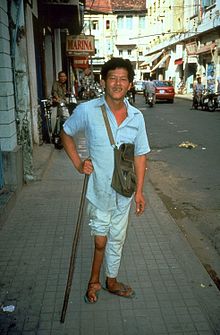| Polio | |
|---|---|
| Other names | Poliomyelitis, infantile paralysis |
 | |
| A man with a smaller right leg due to poliomyelitis | |
| Pronunciation | |
| Specialty | Neurology, infectious disease |
| Symptoms | Muscle weakness resulting in an inability to move[1] |
| Complications | Post-polio syndrome[2] |
| Usual onset | Few hours to days[1][3] |
| Causes | Poliovirus spread by fecal-oral route[1] |
| Diagnostic method | Finding the virus in the feces or antibodies in the blood[1] |
| Prevention | Polio vaccine[3] |
| Treatment | Supportive care[3] |
| Frequency | 176 wild cases (2019)[4] |
Polio, short for poliomyelitis, is an infectious disease caused by the poliovirus.[1] In about 0.5 percent of cases, there is muscle weakness resulting in an inability to move.[1] This can occur over a few hours to a few days.[1][3] The weakness most often involves the legs, but may less commonly involve the muscles of the head, neck and diaphragm.[1] Many people fully recover.[1] In those with muscle weakness, about 2 to 5 percent of children and 15 to 30 percent of adults die.[1] For all those infected, in up to 70 percent of infections there are no symptoms.[1] Another 25 percent of people have minor symptoms such as fever and a sore throat, and up to 5 percent have headache, neck stiffness and pains in the arms and legs.[1][3] These people are usually back to normal within one or two weeks.[1] Years after recovery, post-polio syndrome may occur, with a slow development of muscle weakness similar to that which the person had during the initial infection.[2]
Poliovirus is usually spread from person to person through infected fecal matter entering the mouth.[1] It may also be spread by food or water containing human feces and less commonly from infected saliva.[1][3] Those who are infected may spread the disease for up to six weeks even if no symptoms are present.[1] The disease may be diagnosed by finding the virus in the feces or detecting antibodies against it in the blood.[1] The disease occurs naturally only in humans.[1]
The disease is preventable with the polio vaccine; however, multiple doses are required for it to be effective.[3] The US Centers for Disease Control and Prevention recommends polio vaccination boosters for travelers and those who live in countries where the disease is occurring.[5] Once infected there is no specific treatment.[3] In 2018, there were 33 cases of wild polio and 104 cases of vaccine-derived polio.[4] This is down from 350,000 wild cases in 1988.[3] In 2018, the wild disease was spread between people only in Afghanistan and Pakistan.[4] In 2019 there were 175 cases of wild polio and 364 cases of vaccine-derived polio.[6]
Poliomyelitis has existed for thousands of years, with depictions of the disease in ancient art.[1] The disease was first recognized as a distinct condition by the English physician Michael Underwood in 1789.[1] The virus that causes it was first identified in 1908 by the Austrian immunologist Karl Landsteiner and his assistant, Erwin Popper.[7] Major outbreaks started to occur in the late 19th century in Europe and the United States.[1] In the 20th century it became one of the most worrying childhood diseases in these areas.[8] The first polio vaccine was developed in the 1950s by Jonas Salk and soon after, Albert Sabin developed an oral vaccine.[9]
References edit
- ^ a b c d e f g h i j k l m n o p q r s t u Hamborsky J, Kroger A, Wolfe C, eds. (2015), "Poliomyelitis", Epidemiology and Prevention of Vaccine-Preventable Diseases (The Pink Book) (13th ed.), Washington DC: Public Health Foundation, (chap. 18), archived from the original on 30 December 2016.
- ^ a b "Post-Polio Syndrome Fact Sheet". NIH. 16 April 2014. Archived from the original on 29 July 2011. Retrieved 4 November 2014.
- ^ a b c d e f g h i "Poliomyelitis Fact sheet N°114". who.int. October 2014. Archived from the original on 18 April 2017. Retrieved 3 November 2014.
- ^ a b c "This page allows you to request a table with AFP/polio data". WHO. Archived from the original on 2 April 2015. Retrieved 8 March 2019.
- ^ "Guidance to US Clinicians Regarding New WHO Polio Vaccination Requirements for Travel by Residents of and Long-term Visitors to Countries with Active Polio Transmission". CDC. 2 June 2014. Archived from the original on 4 June 2014. Retrieved 4 June 2014.
- ^ "GPEI-This Week". Archived from the original on 25 January 2017. Retrieved 22 December 2019.
- ^ Daniel, Thomas M.; Robbins, Frederick C. (1997). "1. A history of poliomyelitis". In Daniel, Thomas M.; Robbins, Frederick C. (eds.). Polio (1st ed.). Rochester, N.Y.: University of Rochester Press. p. 11. ISBN 1-878822-90-X.
- ^ Downes, John J. (2009). "1. Development of pediatric critical care medicine- how did we get here and why?". In Wheeler, Derek S.; Wong, Hector R.; Shanley, Thomas P. (eds.). Science and practice of pediatric critical care medicine. London: Springer. pp. 10–11. ISBN 978-1-84800-920-2.
- ^ Helfrich, Alison M.; Tajnik, Michael (2022). "7. Poliomyelitis (polio) and polio viruses". In Jong, Elaine C.; Stevens, Dennis L. (eds.). Netter's Infectious Diseases (2nd ed.). Philadelphia: Elsevier. pp. 29–33. ISBN 978-0-323-71159-3. Archived from the original on 20 October 2023. Retrieved 25 September 2023.